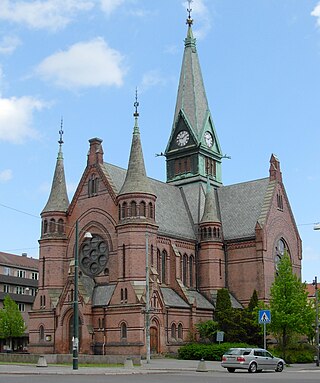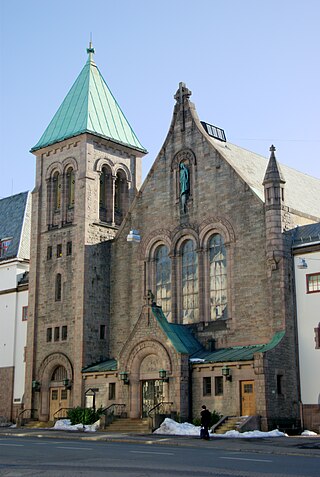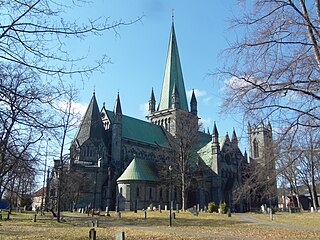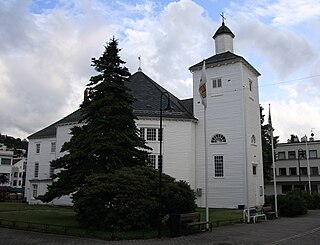
Oslo Cathedral — formerly Our Savior's Church — is the main church for the Church of Norway Diocese of Oslo, as well as the parish church for downtown Oslo. The present building dates from 1694 to 1697.

Jugendstilsenteret is an Art Nouveau Center located in central Ålesund, in Møre og Romsdal, Norway.

Sagene Church is located in Oslo, Norway. The church is one of the most rugged and prominent in Oslo. The church was built in gothic revival style and it was consecrated in 1891. It was designed by architect Christian Fürst in neo-Gothic style. There are 600 seats.

Frogner Church is a parish church in the Frogner borough of the city of Oslo, Norway. The congregation is part of the Oslo arch-deanery within the Diocese of Oslo in the Church of Norway.

Vår Frue Church is a medieval parish church of the Church of Norway in Trondheim municipality in Trøndelag county, Norway. It is located in the downtown Midtbyen area of the city of Trondheim, just a few blocks north of the Nidaros Cathedral. It is one of the two churches for the Nidaros og Vår Frue parish which is part of the Nidaros domprosti (arch-deanery) in the Diocese of Nidaros. The gray, stone church was built in a long church design in the late 1100s using plans drawn up by Bjørn Sigvardsson. The church seats about 540 people.

Lademoen Church is a parish church of the Church of Norway in Trondheim municipality in Trøndelag county, Norway. It is located in the Lademoen area of the city of Trondheim, immediately north of the old European route E6 highway. It is one of the churches for the Bakklandet og Lademoen parish which is part of the Nidaros domprosti (arch-deanery) in the Diocese of Nidaros. The stone-and-brick Art Nouveau church was built in a cruciform style in 1905 using plans drawn up by the architect Ole Stein. The church seats about 500 people, making it the second-largest church in Trondheim.

Løten Church is a parish church of the Church of Norway in Løten Municipality in Innlandet county, Norway. It is located in the village of Løten. It is the main church for the Løten parish which is part of the Hamar domprosti (deanery) in the Diocese of Hamar. The white, stone church was built in a long church design around the year 1200 using plans drawn up by an unknown architect. The church seats about 400 people.

Fredrikstad Cathedral is a cathedral located in the west of the city of Fredrikstad in Østfold county, Norway. It is the episcopal seat of the Diocese of Borg of the Church of Norway. The church was elevated to cathedral status in 1969 with the creation of the new Diocese of Borg. The cathedral has space for 1100 people.

Skien Church is a parish church of the Church of Norway in Skien Municipality in Telemark county, Norway. It is located in the town of Skien. It is the church for the Skien parish which is part of the Skien prosti (deanery) in the Diocese of Agder og Telemark. The red brick church was built in a cruciform design in 1894 using plans drawn up by the architect Hagbarth Martin Schytte-Berg. The church seats about 1,050 people.

Grønland Church is a church located in the neighbourhood of Grønland in the borough of Gamle Oslo in Oslo, Norway.

Nordlandet Church is a parish church of the Church of Norway in Kristiansund Municipality in Møre og Romsdal county, Norway. It is located on the western end of the island of Nordlandet in the town of Kristiansund. It is the church for the Nordlandet parish which is part of the Ytre Nordmøre prosti (deanery) in the Diocese of Møre. The gray, stone church was built in a cruciform design in 1914 by the architect Hagbarth Martin Schytte-Berg. The church seats about 700 people.

Church building in Norway began when Christianity was established there around the year 1000. The first buildings may have been post churches erected in the 10th or 11th century, but the evidence is inconclusive. For instance under Urnes Stave Church and Lom Stave Church there are traces of older post churches. Post churches were later replaced by the more durable stave churches. About 1,300 churches were built during the 12th and 13th centuries in what was Norway's first building boom. A total of about 3,000 churches have been built in Norway, although nearly half of them have perished. From 1620 systematic records and accounts were kept although sources prior to 1620 are fragmented. Evidence about early and medieval churches is partly archaeological. The "long church" is the most common type of church in Norway. There are about 1620 buildings recognized as churches affiliated with the Church of Norway. In addition, there are a number of gospel halls belonging to the lay movement affiliated with the Church of Norway as well as churches belonging to other Christian bodies. Until the 20th century, most churches were built from wood. 220 buildings are protected by law, and an additional 765 are listed as valuable cultural heritage.

Eidsberg Church is a parish church located at Eidsberg in Østfold county, Norway. The Church is located down to the river Glomma by the side of the County Road 124. Eidsberg Church is associated with the Østre Borgesyssel deanery of the Diocese of Borg.

Flekkefjord Church is a parish church of the Church of Norway in the large Flekkefjord Municipality in Agder county, Norway. It is located in the town of Flekkefjord. It is the church for the Flekkefjord parish which is part of the Lister og Mandal prosti (deanery) in the Diocese of Agder og Telemark. The white, wooden church was built in the Empire style and in an octagonal design in 1833 using plans drawn up by the architect Hans Linstow. The church seats about 650 people.

Ljan Church is a parish church of the Church of Norway in the district of Nordstrand in Oslo, Norway.

Bygdøy Church is a church that was built in a fan plan in 1968 on the peninsula of Bygdøy in Oslo, Norway. It replaced the Bygdøy chapel, which burned ten years earlier.

Eidsvoll Church is a cruciform church from c. 1190 in Eidsvoll, Akershus in Norway. The Romanesque building is of stone and probably one of the first cruciform stone churches to be built in Norway. Close to Eidsvoll Church there is an ancient sunken lane that was used as a path far into the last century. Eidsvoll Church is listed and protected by law by the Norwegian Directorate for Cultural Heritage.
Art Nouveau temples are churches, chapels, synagogues, and mosques built in the style known as Art Nouveau in French and English languages, Jugendstil in Germany and Nordic countries, Secessionsstil in countries of former Austro-Hungary, Modernisme in Catalan, Modern in Russian, Stile Liberty or Stile Floreale in Italian. As National Romantic style is also referred to Art Nouveau, churches of that style are also listed here, as well as some temples not of pure Art Nouveau style but with distinctive Art Nouveau features.

Stovner Church is a church center in Oslo, Norway.

Kodal Church is a parish church of the Church of Norway in Sandefjord Municipality in Vestfold county, Norway. It is located in the village of Kodal. It is the church for the Kodal parish which is part of the Sandefjord prosti (deanery) in the Diocese of Tunsberg. The white, stone church was built in a long church design around the year 1100 using plans drawn up by an unknown architect. The church seats about 225 people.





















